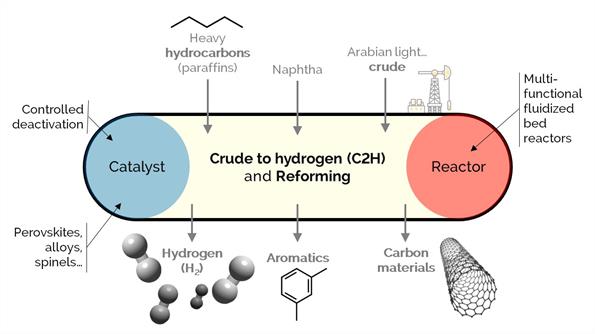
Hydrogen is a clean energy source and carrier because of its non−polluting combustion, making it an excellent alternative to the current fossil fuel-dominated energy scenario. Nonetheless, there are several critical challenges to implementing a broad sustainable use of hydrogen. In this project, we develop a laboratory−scale setup with stable operation and high hydrogen production.
We aim at assessing (i) different hydrocarbon feedstock (from n-heptane to crude oil) fed to the reactor with water as emulsions, carried by steam or vaporized; (ii) steam reforming (SR) and auto thermal reforming (ATR); and (iii) stable and energy efficient catalysts for the efficient production of hydrogen inside packed, fluidized, and multifunctional reactors. These, coupled with carbon capture technologies, minimize the carbon footprint of the overall process.
We support our research with simulations and techno−economic analysis to assess the approach's feasibility. C2H can use the current refinery infrastructure to reduce costs and the impact of market volatility on refinery operations.

Undoubtedly, hydrogen (H2) is a clean feedstock and energy carrier whose sustainable production should be anticipated. The pyrolysis of biomass or waste plastics and the subsequent reforming over base (transition) or noble metals supported catalysts allows reaching elevated H2 yields. However, the catalyst used in the reforming step undergoes a rapid and severe deactivation by means of a series of physicochemical phenomena, including metal sintering, metallic phase oxidation, thermal degradation of the support and, more notoriously, coke deposition. This review deals with the currently existing alternatives at the catalyst and reactor level to cope with catalyst deactivation and increase process stability, and then delves with the fundamental phenomena occurring during this catalyst deactivation. An emphasis is placed on coke deposition and its influence on deactivation, which depends on its location, chemical nature, morphology, precursors or formation mechanism, among others. We also discuss the challenges for increasing the value of the carbon materials formed and therefore, enhance process viability.